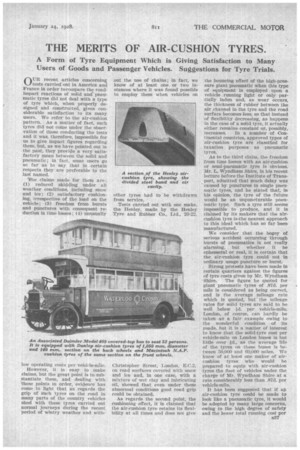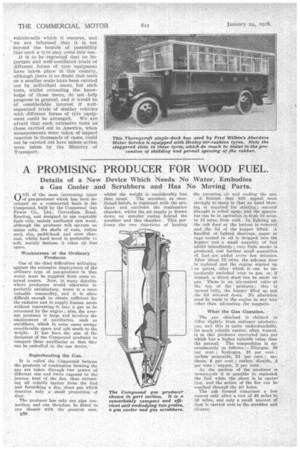THE MERITS OF AIR-CUSHION TYRES.
Page 55

Page 56

If you've noticed an error in this article please click here to report it so we can fix it.
A Form of Tyre Equipment Which is Giving Satisfaction to Many Users of Goods and Passenger Vehicles. Suggestions for Tyre Trials.
OUR recent articles concerning tests carried out in America and France in order to compare the roadimpact reactions of solid and pneumatic tyres did not deal with a type of tyre which, when properly designed and constructed, gives considerable satisfaction to its many users. We refer to the air-cushion pattern. As a matter of .fact, such tyres did not come under the observation of those conducting the tests and it was, therefore, impossible for us to give impact figures regarding them, but, as we have pointed out in the past, they provide a very satisfactory mean between the solid and pneumatic; in fact, some users go so far as to say that in certain respects they are preferable to the last named.
The claims made for them are: (1) reduced skidding under all weather conditions, including snow and ice ; (2) satisfactory cushioning, irrespective of the load on the vehicle; (3) freedom from bursts and punctures with consequent reductiori in time losses; (4) unusually low operating costs per vehicle-mile.
However, it is easy to make claims, but the great point is to substantiate them, and dealing with these points in order, evidence has come to light that as regards the grip of such tyres on the road in many parts a the country vehicles shod with these tyres carried out normal journeys during the recent period of wintry weather and with
out the use of chains; in fact, we know of at least one or two instances where it was found possible to employ them when vehicles on other tyres had to be withdrawn from service.
Tests carried out with one make, the Henley, made by the Henley Tyre and Rubber Co., Ltd., 20-22, Christopher Street, London, E.C.2, on road surfaces covered with snow and ice and, in one case, with a mixture of wet clay and lubricating oil, showed that even under these abnormal conditions good road grip could be obtained.
As regards the second point, the cushioning effect, it is claimed that the air-cushion tyre retains its flexibility at all times and does not give
the bouncing effect of the high-pressure giant pneumatic when this type of equipment is employed upon a vehicle running light or only partially laden and, as wear occurs, the thickness of rubber between the air channel in the tyre and the road surface becomes less, so that instead of flexibility decreasing, as happens in the case of a solid tyre, it actually either remains constant or, possibly, increases. In a number of Continental countries, approved types of air-cushion tyre are classified for taxation purposes as pneumatic tyres.
As to the third claim, the freedom from time losses with an air-cushion or semi-pneumatic tyre is obvious. Mr. L. Wyndham Shire, in his recent lecture before the Institute of Transport, admitted that much delay was caused by punctures in single pneumatic tyres, and he stated that, in his opinion, the tyre of the future would be an unpuncturable pneumatic type. Such a tyre still seems impossible to produce, and it is claimed by its makers that the aircushion tyre is.the nearest approach to this ideal which has so far been manufactured.
We consider that the bogey of serious accident occurring through bursts of pneumatics is not really alarming, but whether it be ephemeral or real, it is certain that the air-cushion tyre could not in ordinary usage puncture or burst.
Strong protests have been made in certain quarters against the figures of tyre costs given by Mr. Wyndham
-Shire. The figure he quoted for giant pneumatic tyres of .874. per mile is considered as being correct, and is the average mileage rate which is quoted, but the mileage rates for solid tyres are said to be well below id. per vehicle-mile. London, of course, can hardly be taken as a fair example owing to the wonderful condition of its roads, but it is a matter of interest to know that the solid-tyre cost per vehicle-mile on London buses is but little over id., as the average life of the tyres on these buses is between 50,000 and 60,000 miles. We know of at least one maker of aircushion tyres who would be prepared to equip with air-cushion tyres the fleet of vehicles under the charge of Mr. Wyndham Shire at a rate considerably less than .874. per vehicle-mile.
It has been suggested that if au air-cushion tyre could be made to look like a pneumatic tyre, it would be adopted by many large concerns, owing to the high degree of safety and the lower total running cost per
vehicle-mile which it ensures, and \..we are informed that it is not beyond the bounds of possibility that such a tyre may come into use.
It is to be 'regretted that no important and well-ventilated trials of different forms of tyre equipment have taken place in this country, although there is no doubt that tests on a smaller scale have been carried out by individual users, but such teSts, whilst extending the knowledge of those users, do not • help -progress in general, and it would be of considerable interest if wellorganized trials of similar vehicles with different forms of tfre equipment could be arranged. We are afraid that such extensive tests as .those carried out in America, when measurements were taken of impact reaction in thousands of cases, could not be carried out here unless action were taken by the Ministry of Transport.




































































































